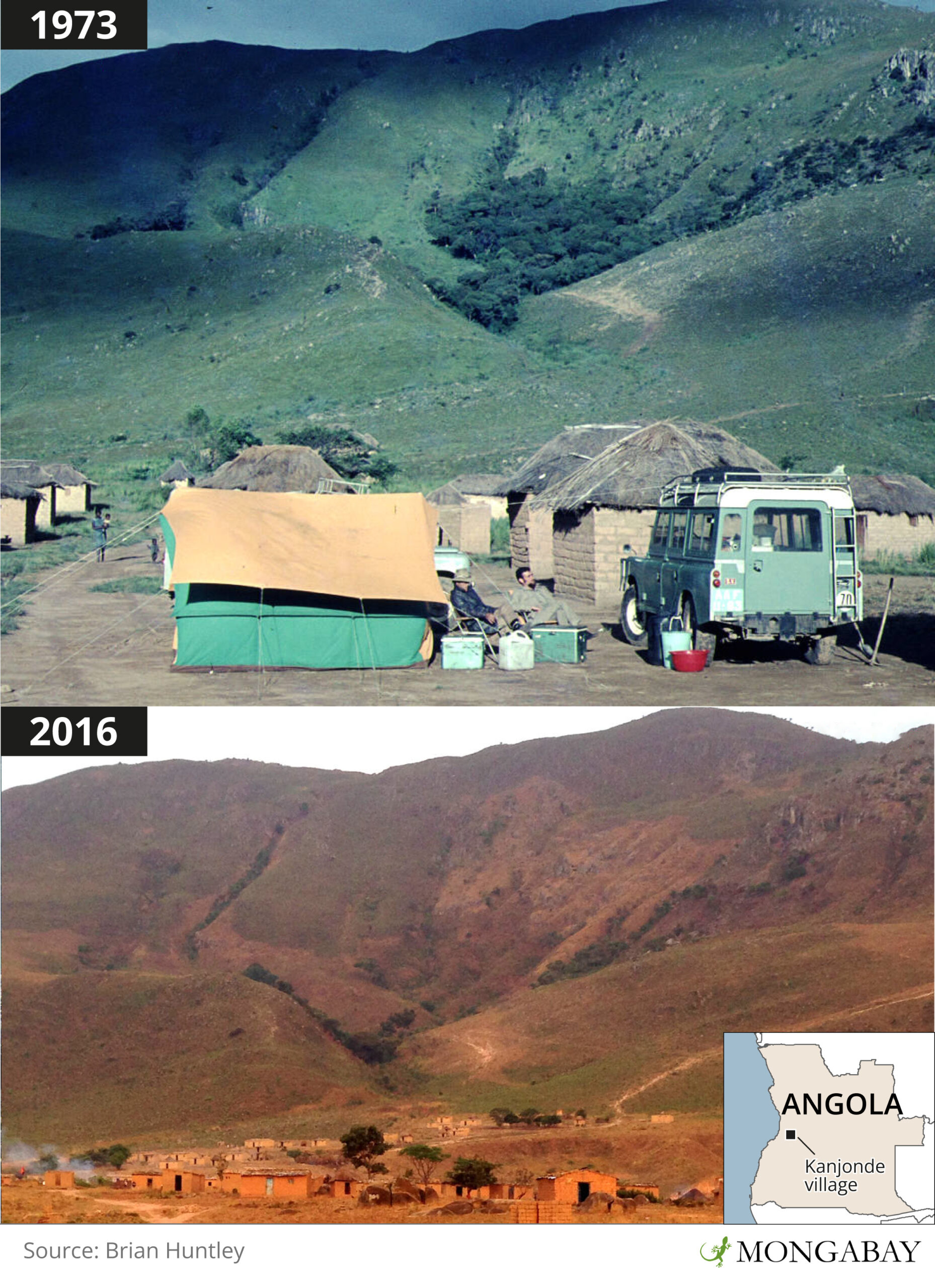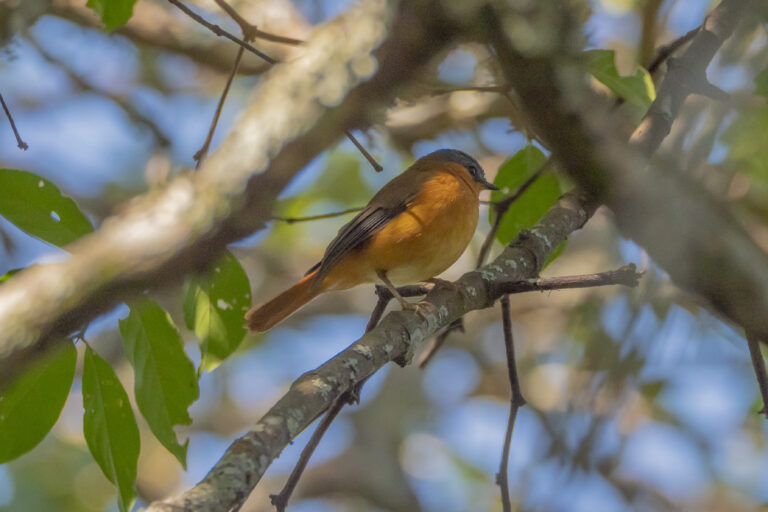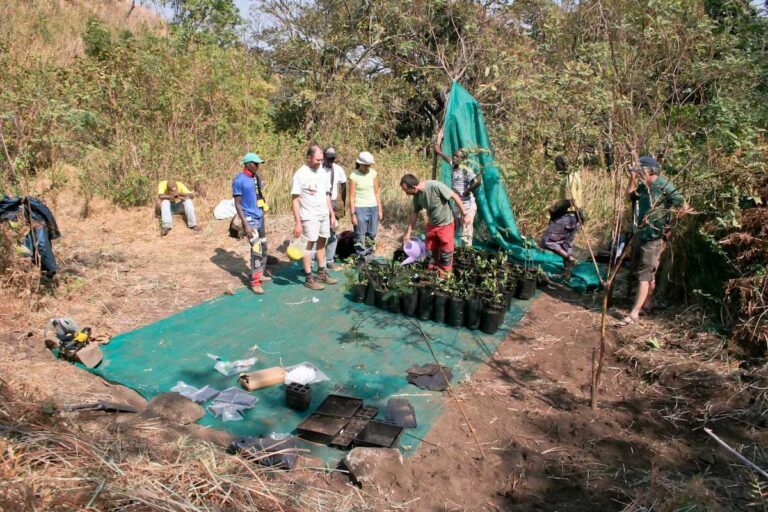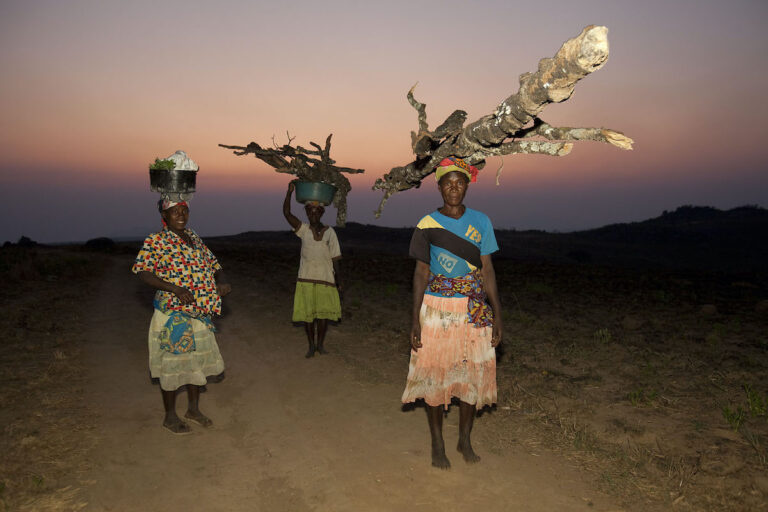Fires and unsustainable wood harvesting have depleted the Afromontane forests on Mount Moco, Angola’s highest mountain.The forests are home to a diverse variety of birds, some found only in Angola.Since 2010, a conservation project has sought to regrow some of the forest patches and to protect them from wildfires.The work is promoting bird conservation, but also benefiting the local human community by ensuring a reliable flow of freshwater out of the forest.
MOUNT MOCO, Angola — On the slopes of Angola’s highest mountain stands the gray jagged stump of a once mighty tree.
It’s the remnant of a Guinea plum (Parinari excelsa), a species native to Mount Moco’s evergreen forests. When South African ornithologist Michael Mills first started to survey the mountain’s forests in 2005, it was a tall tree with a crown of evergreen leaves flourishing beside a small stream.
“A fire got in, and got into the roots and killed it,” he says.
The mountain’s Afromontane forests once formed large, dark-green patches against the lighter green and golden-brown shades of Moco’s grasslands as they changed with the seasons. Fires and the harvesting of timber for firewood and building materials have reduced many of these forest patches to narrow ribbons surviving along steep gullies and ravines.
This makes it easier for them to be overrun by fires or other threats, as no part of these remnants is far from the edge.
“If you had a completely circular patch it would have much less edge than a patch with the same area which is long and narrow,” Mills says.
Afromontane forests are high-altitude evergreen rainforests that are isolated remnants of a once widespread ecosystem now confined to mountainsides and hilltops across East, Southern and Central Africa.
In 1973, the forest above the village of Kanjonde was large and circular, with a well-developed canopy, according to one historical photograph. A photograph taken in 2016 from the same position shows that almost all the trees in that original forest patch were gone, leaving only a narrow strip along the sides of a deep gorge. From an estimated 200 hectares (about 500 acres) in the 1970s, the mountain’s forest patches now total less than 85 hectares (210 acres).
The forest degradation is probably the reason four species of Moco’s forest birds are now locally extinct: Laura’s woodland warbler (Phylloscopus laurae), the bar-tailed trogon (Apaloderma vittatum), the orange ground thrush (Geokichla gurneyi) and the pale-throated barbet (Gymnobucco vernayi) have all fallen silent.
Mills says he last heard a woodland warbler here in 2008 and saw his last trogon, a female, in 2010.
The village of Kanjonde basks in the glow of evening light. Early each morning, a gong sounds out to call members to church, and singing voices drift across the mountainside as dawn colors the sky above Mount Moco a vivid orange. Image by Ryan Truscott for Mongabay. Two photos of Kanjonde, taken 40 years apart: the large patch of forest seen above the village in 1973 had been reduced to a fraction of its original size by 2016. Images courtesy Brian Huntley.
Two photos of Kanjonde, taken 40 years apart: the large patch of forest seen above the village in 1973 had been reduced to a fraction of its original size by 2016. Images courtesy Brian Huntley.
Reforestation gathering pace
Mills has been working ever since to turn things around, and is currently contracted by Angolan conservation group the Kissama Foundation to run a project with funding from the U.K.-based World Land Trust. Among some of the key strategies are tree planting and fire prevention.
Not far from the stump of the Guinea plum is a pilot reforestation plot and tree nursery that Mills and colleagues started 14 years ago. The nursery is located in the heart of the original forest patch, on land owned by the village, and employs 12 workers from the village on a part-time basis: four men and eight women. Dozens more are hired to help during tree-planting days.
Shade netting that was used in 2010 to shield the seedlings from the sun is now rolled into bundles. The trees planted back then have grown big enough to provide deep shade. Among them are a number of yellowwood trees (Podocarpus latifolius). Because of their valuable timber, all the yellowwoods had been harvested here and seedlings had to be brought across from an isolated forest patch on the far side of the massif.
“We didn’t find a single Podocarpus this side of the mountain, not one,” Mills says. “We’ve just been finding individual small trees, saplings, in the understory [of the other forest patch], and bringing them down.”
Since 2011, the project has planted more than 4,000 trees. Mongabay was present early one morning in February when dozens of part-time workers from Kanjonde, some of them women with babies strapped to their backs, carried another 420 potted seedlings from the nursery to a patch of degraded forest targeted for restoration.
Although they’ll take 40 to 50 years to reach maturity, younger trees quickly increase the “woody biomass” that helps reconnect forest fragments and create vital bird habitat. Species that had been absent have started to come back.
In the restored forest patch near the nursery, for instance, Mills has seen the return of Bocage’s akalats (Sheppardia bocagei), robin-like birds with bright orange breasts and tails, and African hill-babblers (Sylvia abyssinica), dainty warblers that issue a torrent of sweet notes like the beeps of Star Wars droid R2-D2.
One prominent bird that’s still absent from this side of the mountain, however, is Margaret’s batis (Batis margaritae). It’s a small black-and-white bird with bright orange eyes that lives and breeds and hunts for insects in the undergrowth of closed-canopy forest. Mills knows of only two to three pairs surviving elsewhere on Mount Moco. It was on this mountain that the species was first collected for science in 1931.
“I guess we’ll gauge the project is a success when we get Margaret’s batis in here and the numbers have increased across the mountain,” Mills says, though he adds he doesn’t know for certain what restricts them to the far side of Mount Moco.
He breaks off suddenly on hearing a bird call from a thick shrub beside the nursery. It’s a Cabanis’s greenbul (Phyllastrephus cabanisi), the first he has recorded in this restored patch of forest.
“Fantastic,” he exclaims.
 Bocage’s akalats, robin-like birds resident in Moco’s Afromontane forest patches, are able to move up and down the mountainside unhindered when forest fragments are rejoined through tree planting. Image courtesy Michael Mills.
Bocage’s akalats, robin-like birds resident in Moco’s Afromontane forest patches, are able to move up and down the mountainside unhindered when forest fragments are rejoined through tree planting. Image courtesy Michael Mills. Michael Mills, at center, with colleagues at the start of the nursery in 2010. Image courtesy Michael Mills.
Michael Mills, at center, with colleagues at the start of the nursery in 2010. Image courtesy Michael Mills. Women from the village of Kanjonde collecting firewood more than a decade ago. The project has now trained villagers to harvest firewood without killing trees, and will establish a woodlot of fast-growing indigenous trees to use as a source of sustainable wood fuel. Image courtesy of Michael Mills.
Women from the village of Kanjonde collecting firewood more than a decade ago. The project has now trained villagers to harvest firewood without killing trees, and will establish a woodlot of fast-growing indigenous trees to use as a source of sustainable wood fuel. Image courtesy of Michael Mills.
Fighting fire
The return of warblers and hill-babblers to the forest patch near the nursery may indicate a recovering ecosystem, but restoring the forest calls for more than replanting trees.
As the jagged stump of the Guinea plum tree constantly reminds the team, protecting the mountain from fire is equally important.
Experts from Working On Fire, a South African environmental organization, have come to Mount Moco for two years running and will return again this May to train 20 men from Kanjonde who are members of a firefighting team.
In 2022, the team burnt its first firebreak, a path 10-15 meters (33-49 feet) wide — too wide for a wild fire to jump across — to shield 188 hectares (465 acres) of Moco’s forest and grassland.
Over a few weeks at the end of each rainy season, they return to dribble burning fuel onto the drying grass to set a fire, and then use fire beaters — large squares of thick flat rubber fixed onto the end of steel poles — to stop the blaze from spreading outside a predetermined path.
Last year, the team burnt firebreaks totaling 15 kilometers (9 miles) in length, providing a protective ring around 400 hectares (nearly 1,000 acres) of forest and grassland. This year, they plan to extend the firebreaks to a total of 22 km (14 mi), encircling habitat that will include a large patch of forest on the southeastern side of the massif known to locals as Luanda, where the Margaret’s batis live and where the yellowwood tree seedlings come from.
Although these fire-prevention efforts are new here, they match traditional ecological knowledge of fire management in this area, says Kerllen Costa, the Angolan project manager at Mount Moco.
“[The Kanjonde villagers] start burning in late April, early May, because they know that if a random fire occurs in September or October, it will be a lot more negative for the vegetation,” he says. “Concepts they had already have been incorporated in our scientific approach, and that has been really the key. If we don’t merge this traditional ecological knowledge to our scientific views, projects won’t really work; communities won’t adhere to [our] strategy.”
 Using a drip torch to light a controlled fire and create a firebreak that will protect threatened Afromontane forest on the slopes of Mount Moco. The team is guided on when to burn firebreaks via traditional ecological knowledge, says project manager Kerllen Costa. Image courtesy Michael Mills.
Using a drip torch to light a controlled fire and create a firebreak that will protect threatened Afromontane forest on the slopes of Mount Moco. The team is guided on when to burn firebreaks via traditional ecological knowledge, says project manager Kerllen Costa. Image courtesy Michael Mills. Mona Bunga, a project coordinator, instructs biodiversity monitor Teresa Sakata on how to use a turbidity tube to measure water quality in a stream flowing out of a restored patch of Afromontane forest. Image by Ryan Truscott for Mongabay.
Mona Bunga, a project coordinator, instructs biodiversity monitor Teresa Sakata on how to use a turbidity tube to measure water quality in a stream flowing out of a restored patch of Afromontane forest. Image by Ryan Truscott for Mongabay.
Broad benefits of restored ecosystems
Habitat restoration work like this isn’t just good for the birds. There’s now a steady supply of freshwater to Kanjonde from the stream that flows out of the forest.
“By protecting the forest we are protecting the river so it can provide healthy water,” says Regina Wimbo, one of the 12 nursery workers who waters and tends to the seedlings and helps carry them across the hillside on planting days.
Wimbo was born and raised in Kanjonde. She says she’s happy to see her work in the nursery now bearing fruit.
“Six years ago we had lower water flow; now we have much more water flowing down,” she says, indicating the stream of crystal-clear water rushing past. There are plans to put in a small weir, and to pipe water directly to the village.
Some residents of Kanjonde are themselves learning how to gather data to measure rates of recovery and keep tabs on potential threats. Like the nursery workers, they’re employed on a part-time basis by the project and its sponsors, and have been trained to survey biodiversity and human environmental impacts at various sites around the village. Birds, plants, wood collection, gulley erosion, fires — they’re all surveyed.
On a Saturday morning after heavy rain, with mist obscuring the top of Mount Moco, a small group of men and women gather beside the stream at a point where villagers collect their drinking water. Members of the group carry clipboards with fact sheets attached, and equipment stored in a long green canvas bag.
Felix Segunda, a member of the eight-strong team of “biodiversity monitors,” takes a long plastic tube out of the bag and fills it with water from the stream. He holds it up toward the sky, one end pressed against his eye. The device is a turbidity tube, used to measure water purity. Many children in the village have suffered from tapeworm parasites obtained through drinking contaminated water. Today’s turbidity level is calculated and deemed “acceptable,” according to Mona Bunga, a project coordinator instructing them on how to use the instrument.
“You can drink directly from here,” he tells the team, and he stoops to drink some from his cupped hand.
Fires threaten Afromontane forests’ ‘whole new world’: Q&A with Martim Melo
Banner image: Kanjonde villagers learning how to measure water quality from a Kissama Foundation instructor. Image by Ryan Truscott for Mongabay.
FEEDBACK: Use this form to send a message to the author of this post. If you want to post a public comment, you can do that at the bottom of the page.
Birds, Community Development, Community-based Conservation, Conservation, Drinking Water, Fire Management, forest degradation, Grasslands, Mountains, Rainforest Destruction, Rainforests, Reforestation
Africa, Angola, Southern Africa
Source link : https://news.mongabay.com/2024/05/a-forest-restoration-project-brings-birdsong-back-to-angolas-highest-mountain/
Author :
Publish date : 2024-05-20 07:00:00
Copyright for syndicated content belongs to the linked Source.





